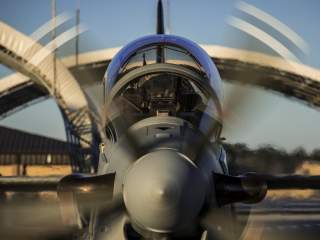Yes, Really, Destroy ISIS With Turboprop Light Attack Aircraft
"The AT-6 Coyote or A-29 Super Tucano require a less constrained basing structure and much less logistical support than their fast jet counterparts."
The incorporation of a rocket-and-guns loadout means that field rearming by the aircrew is a practical possibility. During the Jaded Thunder 10-1 exercise, the Navy validated its light attack concept using an armed A-29. These planes repeatedly demonstrated rapid turns at Creech Air Force Base, as summarized in the after action report:
From two austere locations, with as little as 40 minutes between events, the aircraft was maintained, refueled, reconfigured between ISR and strike configurations, rearmed with multiple loads of rockets and guns, and launched / recovered during day and night operations. FARP evolutions were limited only to the Creech AFB fuel truck timelines, but were always accomplished in under 20 minutes from touchdown to launch. Incorporating organic refueling with fuel bladders by Imminent Fury maintainers would have cut each of the FARP evolutions from 20 minutes to 7-10 minutes.
Cost
We can draw the current cost estimates for purchasing turboprop light attack aircraft from existing contracts for the Super Tucano. The typical contract is for a small package of aircraft — less than a squadron — and include training devices, simulators, two years of support and a robust spares kit.
In 2004, Colombia bought 25 Super Tucanos for $235 million, plus another $89 million to cover purchase of the EO/IR sensors. In 2013, the Light Air Support contract, covering 20 aircraft, was negotiated for $421 million dollars.
While the individual aircraft, combat equipped with EO/IR ball run about $14 million, the support contracts, training devices and spare parts accounted for a third or more of the total contract cost. The Colombian contract remains the largest contract executed to date outside Brazil.
There are other cost analyses which include data on sustainment estimates here, here, here and here. For a smaller demonstration along the lines of Imminent Fury, both manufacturers have previously offered lease options on their aircraft.
Air power options
For policymakers who are reasonably wary of introducing additional ground forces into Iraq, the option of providing these forces with additional protection and on-call air power should be an attractive policy choice.
The Air Force does not currently possess operational attack aircraft that can operate out of northern Iraq, but those aircraft are available, and we have aircrew—including the author—with varying degrees of familiarity with the AT-6 and A-29.
The majority of the burden for rolling back Islamic State territorial gains will fall on Iraqi and Kurdish ground forces, but air power has proven itself effective when supporting those operations.
With a minor adjustment to our force structure, we could improve air power flexibility, shorten the response timeline and reduce risk to deployed forces by basing combat aircraft inside Iraq itself. The Air Force could send light attack planes in short order—to provide air power where we need it.
Michael W. Pietrucha was an instructor and electronic warfare officer in the F-4G Wild Weasel and the F-15E Strike Eagle, amassing 156 combat missions and taking part in 2.5 SAM kills over 10 combat deployments. As an irregular warfare operations officer, Pietrucha has two additional combat deployments in the company of U.S. Army infantry, combat engineer and military police units in Iraq and Afghanistan. This article first appeared in War in Boring.
Image: Flickr/Aiirsource

